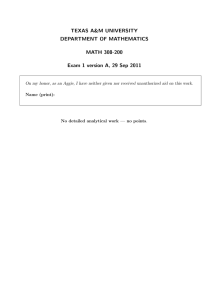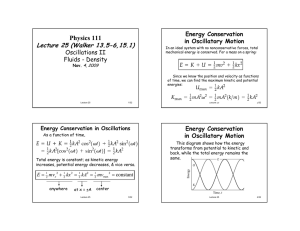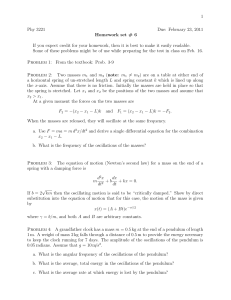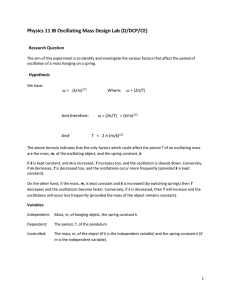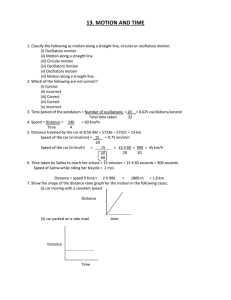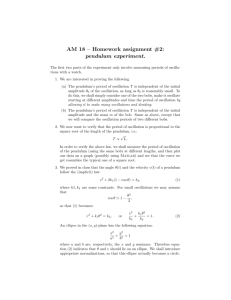Document 10847046
advertisement
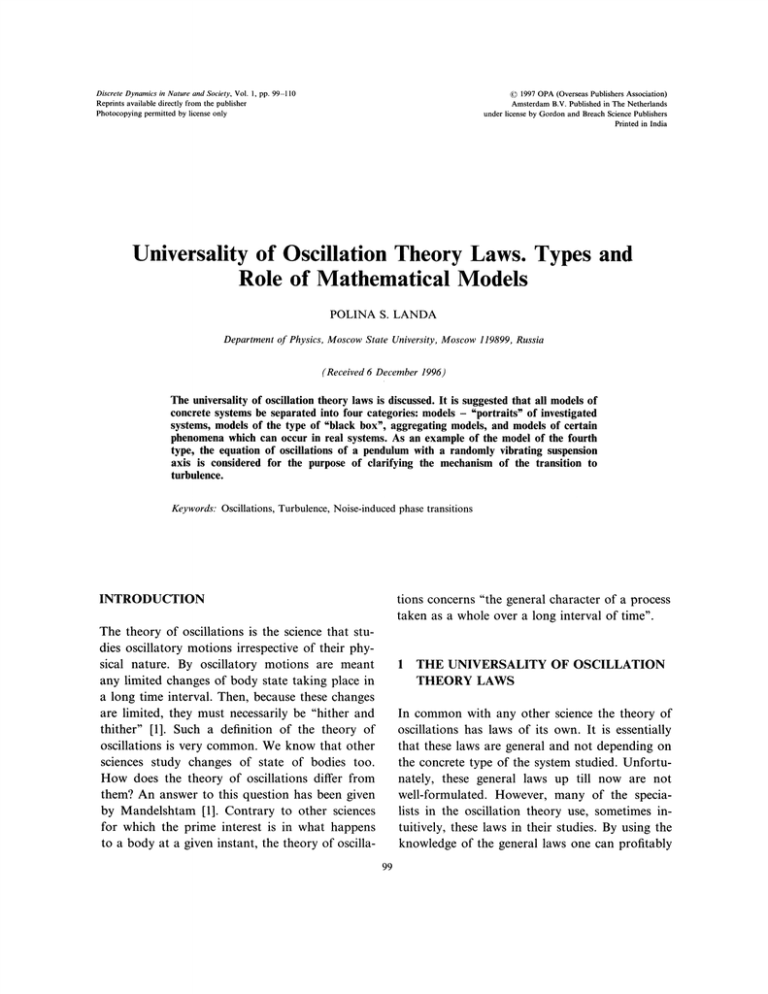
Nature and Society, Vol. 1, pp. 99-110
Reprints available directly from the publisher
Photocopying permitted by license only
(C) 1997 OPA (Overseas Publishers Association)
Amsterdam B.V. Published in The Netherlands
under license by Gordon and Breach Science Publishers
Printed in India
Discrete Dynamics in
Universality of Oscillation Theory Laws. Types and
Role of Mathematical Models
POLINA S. LANDA
Department of Physics, Moscow State University, Moscow 119899, Russia
(Received 6 December 1996)
The universality of oscillation theory laws is discussed. It is suggested that all models of
concrete systems be separated into four categories: models ‘‘portraits" of investigated
systems, models of the type of "black box", aggregating models, and models of certain
phenomena which can occur in real systems. As an example of the model of the fourth
type, the equation of oscillations of a pendulum with a randomly vibrating suspension
axis is considered for the purpose of clarifying the mechanism of the transition to
turbulence.
Keywords." Oscillations, Turbulence, Noise-induced phase transitions
INTRODUCTION
tions concerns "the general character of a process
taken as a whole over a long interval of time".
The theory of oscillations is the science that studies oscillatory motions irrespective of their physical nature. By oscillatory motions are meant
any limited changes of body state taking place in
a long time interval. Then, because these changes
are limited, they must necessarily be "hither and
thither" [1]. Such a definition of the theory of
oscillations is very common. We know that other
sciences study changes of state of bodies too.
How does the theory of oscillations differ from
them? An answer to this question has been given
by Mandelshtam [1]. Contrary to other sciences
for which the prime interest is in what happens
to a body at a given instant, the theory of oscilla-
THE UNIVERSALITY OF OSCILLATION
THEORY LAWS
In common with any other science the theory of
oscillations has laws of its own. It is essentially
that these laws are general and not depending on
the concrete type of the system studied. Unfortunately, these general laws up till now are not
well-formulated. However, many of the specialists in the oscillation theory use, sometimes intuitively, these laws in their studies. By using the
knowledge of the general laws one can profitably
99
100
P.S. LANDA
predict different phenomena from diversified areas
of science. The discovery of light combination
scattering effect by Mandelshtam [2] is a typical
example of such a prediction. As for the analogy
between light combination scattering and the
usual objects of oscillation theory, Mandelshtam
wrote [3], "From the point of view of the theory
of oscillations, wireless telephony and light combination scattering are the same. It is modulation. Sound--in radio, and atomic oscillations--in
combination scattering". Thus, one of the general
laws of the oscillation theory, which implies that
in any nonlinear system modulation is possible,
was the basis for Mandelshtam’s prediction. Another example of the general laws of the oscillation theory is the possibility of synchronization
of any self-oscillatory system by means of the
corresponding external action with different mechanisms of the synchronization in the cases of
slight and strong actions [4-6]. As a further example we can point to the possible routes for the
appearance of chaos and stochasticity in any selfoscillatory systems [7].
The knowledge of the general laws of the oscillation theory is also important in that for study
of any oscillatory phenomena one can use simple
models and be sure that in concrete more complicated systems these phenomena will be also of
the same character. This fact is used tacitly by all
researchers.
It is evident that the general laws of the oscillation theory must manifest themselves identically
in systems of diversified physical nature. Regarding this, Mandelshtam told students in one of his
lectures on the theory of oscillations, "All of you
know such systems as a pendulum and an oscillatory circuit, and also know that from the oscillatory point of view they are similar. Now all this
is trivial, but it is wonderful that this is trivial."
These ideas have not yet become fashionable. In
the paper "L.I. Mandelshtam and the theory
of non-linear oscillations" Andronov [8] wrote
of the lectures and seminars of Mandelshtam,
"Lectures and seminars of Mandelshtam have
sometimes contained new scientific results which
were not published. But, perhaps the greatest significance of these lectures lies in the methodical
inculcating of habits of oscillatory thinking, in the
general rise of the oscillatory culture". Unfortunately, many even prominent scientists, studying
concrete problems, are still lacking in "oscillatory
culture". This is the main cause of the fact that
up to the present the scientific works, which are
absolutely erroneous from the point of view of
the general laws of the oscillation theory, occur
from time to time.
There is much speculation that the generality
of the laws of the oscillation theory is based on
the similarity of the equations describing oscillatory processes in different systems. Every so often
this is so indeed. However, the laws mentioned
above (and many other ones) are independent of
the concrete form of the equations. It is only
sufficient that the equations belong to a certain
class, which in common is moderately broad.
TYPES OF MATHEMATICAL MODELS
AND THEIR ROLE
The availability of analogies between oscillatory
processes in systems of diversified physical nature
is why the theory of oscillations got its subject of
investigation, and thereby took the status of an
original science. A dynamical system is such a
subject [9,10]. A dynamical system is a system
whose behavior is predetermined by a set of rules
(algorithm). In particular, and most frequently,
the behavior of a dynamical system is described
by differential, integral or finite-difference equations. Obviously, a dynamical system is a model
of a real system. So we can say that the theory
of oscillations studies abstract models, but not
concrete systems. These models can be conventionally separated into four categories: models
"portraits" of investigated systems, models of the
In western literature this effect is usually called the Raman effect.
UNIVERSALITY OF OSCILLATION THEORY LAWS
type of "black box", aggregating models, and
models of certain phenomena which can occur in
real systems.
The models of the first type are constructed on
the basis of the description, as more detailed as
possible, of all elements of the system studied.
Such models, e.g., are studied in physics. An example is the Navier-Stokes equations and their
finite-difference approximations describing fluid
motion with a high degree of accuracy. As another example we can point to certain models of
heart activity or breathing [11]. These models, as
a rule, are very complicated and cumbersome for
detailed analysis and revealing principal features
of system’s behavior.
When the models of the second type are constructed, the system studied is considered as a
certain "black box" with given inputs and the outputs which are able to be measured. Further, a
model, as simpler as possible, is chosen. The free
parameters of this model are determined from the
conditions of the minimum, according to a given
criterion, of the difference between the model and
the system outputs for identical inputs. A number
of examples of such models for chemical reactions
is given in [12]. The same approach is conceptually used for reconstruction a model from experimental data (see, for example, [13]).
The models of the third type are constructed
on the basis of the analysis of aggregate behavior
of individual elements of the system studied. A
classical example of the models of this type is
the model "prey-predator" by Lotka-Volterra
[14,15]. The other interesting examples are the
model of an immune reaction illustrating an
oscillatory course of some chronic diseases [16,10]
and the model of the economic progress of human society [17,10].
Finally, the models of the fourth type are constructed for analysis of a certain phenomenon no
matter in what system it occurs. For example,
the phenomenon of self-excitation of selfoscillations can be modeled by the van der Pol
equation; the phenomenon of synchronization of
periodic self-oscillations can be also modeled by
101
the van der Pol equation but with an external
force; oscillatory character certain chemical reactions is demonstrated by the models "brusselator" and "oregonator"; the transition to chaos
via an infinite period-doubling bifurcation sequence can be modeled by a logistic map [18];
the transition to chaos via intermittency can be
modeled by a map of the form [7]
Xn+l
Xn
-[-ax,,
where z is an even number, a is the parameter;
some processes in continuous media can be modeled by coupled map lattices [19]. Similar examples can be given in abundance. It should be
particularly emphasized that the mere possibility
and utility of such models are based on the universality of the oscillation theory laws.
THE TRANSITION TO TURBULENCE
AND OSCILLATIONS OF A PENDULUM
CAUSED BY RANDOM VIBRATION OF
ITS SUSPENSION AXIS
In this section we dwell more closely on .a model
of the transition to turbulence in the form of the
equation of oscillations of a pendulum with a
randomly vibrating suspension axis [20]. In [21,
22,10] we hypothesized that turbulent processes
in nonclosed fluid flows are not self-oscillations
but are caused by fluctuations both internal (natural) and external (technical). This hypothesis is
based on the fact that instability of nonclosed
laminar flows is convective. By this is meant that
a small disturbance being given at some point
of the flow will not indefinitely increase with
time but will drift downstream. It follows from this
property of convectively unstable systems that
they are not self-oscillatory systems, but only
amplifiers of disturbances. To make these systems self-oscillatory it is necessary to form feedback. However, in nonclosed flows such feedback
is absent, i.e. for sufficiently large Reynolds’ numbers such flows are amplifiers of fluctuations.
P.S. LANDA
102
Because the turbulent processes closely resemble self-oscillations in appearance, we further
suggested that owing to the amplified fluctuations
a certain phase transition can occur in the fluid
flow and, as a result, the flow transforms into a
qualitatively new state associated with the excitation of noise-induced self-oscillations. It can be
believed that the onset of turbulence, which is
characterized by presence of large-scale, comparatively regular, structures against a background of fine-scale random motions, is just such
a transition. To make sure that such a transition
is possible in principle, we studied, both analytically and numerically, a simple model in the form
of the equation for oscillations of a pendulum
with a randomly vibrating suspension axis
[23,24].
where
is the parameter characterizing the extent to
which the noise intensity is in excess of its critical
value for which the phase transition arises,
-7+aw02, 7 is the coefficient of the first
nonlinear term in the expansion of sin
K1
(2w0)/2 is the parameter characterizing the
intensity of suspension axis’ vibration, (t) is a
random process with zero mean value and the
intensity K1, M ( cos 2 ), and (2(t), much like
to (l(t), is a random process with zero mean value
and the intensity K2 (n(0) + K1)/4.
The Fokker-Planck equation associated with
Eqs. (2) is
,
Ow(A, )
Ot
3.1 Noise-Induced Oscillations of a Pendulum
with a Vibrating Suspension Axis
Aw(A,
The equation studied is
b + 2/3(1 + og(2) +w(1 + (t))sin g)
Wo
0,
is the pendulum’s angular deviation
where
from the equilibrium position, 2/3(1 + Og2)( is
the value proportional to the moment of the
friction force which is assumed to be nonlinear,
w0 is the natural frequency of small pendulum’s
oscillations, and (t) is the acceleration of the
suspension axis that is a comparatively wideband random process with nonzero power spectrum density n(w) at the frequency w= 2w0.
Setting T A cos(w0t + 4)) and solving Eq. (1) approximately by the Krylov-Bogolyubov method
we obtain the following truncated equations for
the amplitude A and phase 4) of the oscillations
[23,24]:
(2)
q
c/) )
(3 TA2 ) Ow(A,oc O)
M
s
K,w
02
80A 2
OZw(A, 4)) (3)
(AZw(A’ 4))) + Kzw
2
0O 2
Finding from this equation the steady-state
probability density for the amplitude A, we can
calculate the mean value of the steady-state amplitude. It is
(A)--
/wgK1 r(l + 1/2)
for
0
for r/< O.
V3--
F07+l)r/
> 0,
It follows from this that for > 0 the parametric
excitation of pendulum’s oscillations occurs under the effect of noise. This manifests itself in the
fact that the mean value of the amplitude becomes different from zero.
Numerical simulation of Eq. (1) showed that,
as one would expect from the theoretical results,
UNIVERSALITY OF OSCILLATION THEORY LAWS
when the intensity of the suspension axis vibration,
characterized by the value of (2v0), is in excess
of a certain critical value cr proportional to the
friction factor /3, the excitation of pendulum’s
oscillations occurs that makes itself evident in the
fact that the variance of the pendulum’s angular
deviation becomes nonzero. This phenomenon
can be considered as a noise-induced phase transition and the birth of an induced attractor. The
latter follows from the fact that the correlation
dimension of the attractor constructed from the
data obtained by the numerical simulation with
using Takens’ technique turns out to be finite
[23,24]. However this attractor is very noisy. This
is evidenced by the fact that the embedding dimension calculated by both well-adapted basis
technique [25] and the method of BroomheadKing [26] is very large.
Examples of the noise-induced oscillations and
the dependence of the variance of the pendulum’s
angular deviation on the relative power spectrum
density (20)/cr found by numerical simulation
of Ec[. (1) are depicted in Fig. 1. It is seen from
this figure that close to the excitation threshold
the pendulum’s oscillations possess the property
of a peculiar kind of intermittency, 2 i.e. over prolonged periods the pendulum oscillates in the
immediate vicinity of its equilibrium position (socalled "laminar" phases); these slight oscillations
alternate with short strong bursts ("turbulent"
phases). Away from the threshold the duration
of laminar phases decreases and of turbulent increases, and laminar phases ultimately disappear.
The variance of the pendulum’s angular deviation increases in the process. We emphasize that
turbulence for transient Reynolds numbers exhibit also this property [29-31]. It is no chance
that the first theoretical works concerning the
intermittency phenomenon were made by the specialists in the field of turbulence [32].
Interestingly enough that in the case of the
pendulum the intermittency observed is different
103
,i
0.0E;
(d)
0.03
0.04
0.02
0.0t
0
t.5;
2
2.S
3 3.;
,q
.; S ..;
,()/()
The dependencies q(t) and b(t) for 0v0=l,
FIGURE
/3:0.1, c: 100 (a) (2)/cr: 1.01, (b) (2)/cr: 1.2, and (c)
(2)/cr:5.6; (d) the dependence of 2 on (2)/cr (the
straight line
line).
2 =0.01151 ((2)/r-1)
is shown as a solid
from all types of the intermittency described in
[27,7,28], although they are similar in their external manifestations. It is so called "on-off-intermittency". 3 The term "on-off-intermittency" was
The intermittency is described, for example, in [27,7,28].
Author is indebted to S.P. Kuznetsov and A. (enys for calling his attention to this fact.
P.S. LANDA
104
recently introduced by Platt et al. [33], though a
map associated with the similar type of intermittent behavior was first considered by Pikovsky
[34]. It is essential that this type of intermittency
can occur not only in dynamical systems but in
stochastic systems as well [35]. In [35] the statistical properties of on-off intermittency were found
from the analysis of the map
a(1 + z,)x, +f(x,),
x,+
where zn is either a certain deterministic chaotic
process or a random process, a is the bifurcation
parameter, f(xn) is a nonlinear function. It was
obtained that the mean duration of laminar
phase has to be proportional to a -1.
Let us calculate the mean duration of laminar
phase using Eqs. (2) and the Fokker-Planck
equation (3) associated with them. We shall assume that the pendulum oscillates in laminar
phase if the oscillation amplitude A is no more
than a certain value e. Then the mean duration
of the laminar phase will be determined by the
mean duration of random walk of the representative point inside the circle of radius e on the
plane o, b. This duration can be calculated (see
[7]) using the steady-state solution of Eq. (3) with
the boundary condition
-
w (A, dP)IA= =0.
(4)
Because the value of e is assumed to be small, we
can neglect the term (3/4)/3-A 2 in Eq. (3). In so
doing the solution of Eq. (3) with the boundary
condition (4) is
w (A, 4)
where
8G0
I_2A 2_
co02K1 (1 2 r/)A (e
Go is the value of the probability flow
4
rl Aw
across any circumference inside the circle of radius
e. The value Go is determined from the normal-
--
ization condition by integrating the expression (5)
over the circle of radius e. Using this condition and
2 G [36] we obtain
taking into account that
16re
(6)
co02K1 r/
It follows from this that for small r/ the mean
duration of the laminar phase is inversely proportional to 7. This result agrees with [35].
If the intensity of the suspension axis random
vibration is under its threshold value then the
excitation of pendulum’s oscillations can be initiated by small additional low-frequency vibration of the suspension axis. The inclusion of this
vibration can be carried out by substitution into
Eq. (1) of + a cos COat in place of where a
and COa are, respectively, the amplitude and frequency of the additional vibration of the suspension axis. The results of numerical simulation of
Eq. (1) for different values of a are represented
in Fig. 2. We see that the excitation of oscillations, as the amplitude a increases, is of a threshold character. For COa 0.318, (2CO0)/t%r --0.51
the threshold value of a is equal to 1.1. The
dependence of the pendulum’s angular deviation
mean square on the difference between the amplitude a and its threshold value is found to be
close to linear (see Fig. 3(a)). For a>ar the
oscillations excited are not distinguished from
those excited due to random vibration only. The
oscillation intensity is greater, the larger the a.
By this is meant that the low-frequency vibration
initiates the noise-induced phase transition and
the birth of the induced attractor. In the case
when the intensity of the suspension axis random
vibration is in excess of its threshold value additional low-frequency vibration contributes significantly to the intensification of noise-induced
1/2
on a for
oscillations. The dependence of 2
t(2)/tcr(2) 2.23, COa 1.5 is given in Fig. 3(b).
Let us consider now a possibility of suppressing noise-induced pendulum’s oscillations by
high-frequency harmonic action. Numerical simulation of Eq. (1) with ( + a cos COat in place of (,
,
UNIVERSALITY OF OSCILLATION THEORY LAWS
105
where COa>20, shows that such suppression
does occur. The results of the simulation for sufficiently large value of 03a are represented in
Fig. 4. It is seen from this figure that, for small
amplitudes of the high-frequency action, the action has little or no effect on the noise-induced
oscillations existing (see Fig. 4(a). As the amplitude increases the intensity of the noise-induced
oscillations decreases rapidly and the duration of
"laminar" phases increases in the process (see
Fig. 4(b-d). When the amplitude is in excess of
a certain critical value (for the case considered it
is equal to 42) the oscillations are suppressed
entirely. As the amplitude increases further the
oscillations arise again, but because the conditions of the corresponding parametric resonance
come into play. If the frequency of the additional
action is not-too-high then the perfect suppression does not occur: as the action amplitude
increases the intensity of the noise-induced oscillations first decreases to a certain minimal value,
which is smaller the greater the action frequency,
and then increases. True, this minimal value is
attained for the larger amplitudes of the action,
the higher its frequency. The aforesaid is illustrated in Fig. 5.
We emphasize that the initiation and suppression of noise-induced pendulum’s oscillations occur
by means not only of additional parametric action, but of additional additive action as well.
FIGURE 2 The dependencies o(t) and qb(t) for wo=l,
/3:0.1, c= 100, (2o0)/cr=0.51, w,:0.318 (a) a= 1.12, (b)
a-- 1.2, and (c) a-- 1.5.
0.4
I .t t .2 1.3 t .4 I .5
(a)
.6 t .7 t .8 t .8
2
(b)
FIGURE 3 The dependencies of o21/e on a for o0--1, /3--0.1, --100 (a) (2w0)/cr:0.51, 0Va’--0.318 (the straight line
I/2
0.48 (a 1.1) is shown as a solid line), (b) #(2w0)/t%r 2.23, o,= 1.5.
qo
P.S. LANDA
106
3.2 The Comparison of the Results of the Study
of Pendulum’s Oscillations with a Number of
Numerical and Real Experiments Concerning
Turbulence in Pipes and Free Jets
A number of numerical and real experiments
b)
concerning turbulence shows that there exist the
profound parallels between turbulent processes
and noise-induced pendulum’s oscillations. These
parallels reinforce our hypothesis about fluctuational origin of turbulence.
One of the indications that turbulence is not a
self-oscillatory process is a numerical experiment
performed by Nikitin [37] which relate to the
simulation of turbulent flow in pipes of a finite
length. He studied fluid flow in a circular pipe of
radius R with a given velocity at the input crosssection and with the so-called soft boundary conditions at the output cross-section; these latter
are
0 2U
OX 2
Oq 2
OX
Oq 2 g]
2
OX 2
where u is the longitudinal component of the flow
velocity, and /are, respectively, the radial and
azimuth components of the vorticity f= rot V,
V--{u, v, w} is the vector of the flow velocity in
cylindrical coordinates x, r, 0. The components of
the flow velocity at the pipe input cross-section
were assigned in the form
u
uo
( r2) +
A Re(u’(r)e-i"’t)cos O,
re(v’(r)e-it)cos O,
A Re(w’(r)e-i"t)sin O,
v- A
w
FIGURE 4 The dependencies of :(t) and qb(t) for v0--1,
/3--0.1, c---100, (200)/cr---5.6, wa= 19.757 (a) a=5, (b)
a 15, (c) a 30, and (d) a--40.
where u’(r), v’(r) and w’(r) are the eigenfunctions
for the Orr-Zommerfeld equation associated with
the given value of the disturbance frequency v, R is
the pipe radius, A is the disturbance amplitude.
The disturbance frequency v was chosen equal
to 0.36uo/R, and the velocity u0 and the pipe
radius R corresponded to the Reynolds number
equal to 4000. At initial instant the Poiseuille
UNIVERSALITY OF OSCILLATION THEORY LAWS
(a)
8.4
107
s.4
8.3
I
L8.2
8.1
8
1.8
18
18
18 e
18 x
18
i"’! ’1
8.4
8.4
8.3
8.3
L8.2
8.1
8
18 e
FIGURE 5 The dependencies of
and (d) Oa= 19.75.
18 j-
on a for w0=l, /3=0.1, c= 100,
velocity profile was given for whole flow., i.e.
v, t=0
_{
b/0
When the disturbance amplitude A stands out
above a certain critical value, after a short time,
random high-frequency pulsations appear in the
lower part of the pipe from a certain value x x0
onward. The value x0 depends only slightly on
the distance from the pipe axis r, and it is the
smaller, the greater is the disturbance amplitude
A. The occurrence of the turbulent pulsations is
accompanied by considerable change of the profile of the mean flow velocity’s longitudinal component: it decreases at the pipe axis and increases
nearby the pipe wall. The instantaneous distributions of the velocity’s longitudinal component in
steady regime are shown in Fig. 6 for A/uo =0.04;
this figure is taken from [37]. If one diminishes
progressively the amplitude of the periodic disturbance A then, from a certain its value onward,
the turbulence region drifts downstream and the
flow in the pipe becomes laminar. As is known
(2)/cr(2)=5.6 (a) a=3.5, (b) wa=6, (c) o= 11,
(see, for example, [38]), the Poiseuille flow in a
circular pipe, as differentiated from the Poiseuille
flow in a plane channel, is stable with respect to
infinitesimal disturbances for any Reynolds numbers. However, in the case of sufficiently large
Reynolds numbers such flow is unstable with respect to disturbances having a finite value. If an
attractor associated with turbulence would exist
in the system as the disturbance is absent and
under the effect of the disturbance the phase trajectory would only come into the attractive domain of this attractor, the turbulence should not
disappear when the disturbance resulting in it was
taken away. The fact that the turbulence disappears implies that such an attractor is absent.
True, it is possible that an attractor comes into
existence under the effect of an asynchronous disturbance in itself (see [39,40]). In this case it has
to disappear when the disturbance ceases. Against
this possibility are the following facts. Firstly, as
is known from the general theory of the asynchronous excitation of oscillations in systems
with hard excitation [39,40] such an attractor can
appear only within a narrow range of system’s
P.S. LANDA
108
0.4
0.7
0.I
0
20
40
60
80
x
100
FIGURE 6 Instantaneous distributions of the steady longitudinal velocity component for A/uo--0.04: (a) close to the pipe axis
(for r/R =0.02) and (b) close to the pipe wall (for r/R =0.93).
parameters, whereas the transition to turbulence
was observed by Nikitin over a wide range of
Reynolds’ numbers. Secondly, asynchronous excitation of self-oscillations, is equally possible both
for positive and negative mistunings between the
frequencies of the disturbance and self-oscillations, whereas the transition to turbulence was
observed only for low disturbance’s frequencies.
As is seen from the foregoing, such asymmetry is
intrinsic just to noise-induced oscillations.
So, the fact that the turbulence disappears,
when the disturbance is taken away, implies that
the turbulent pulsations resulting from the disturbance are more likely to be noise-induced oscillations than self-oscillations. Therefore it can be
conjectured that the turbulence development observed for A > Acr is a result of the noise-induced
phase transition bringing into existence an induced attractor. The similarity of the characteristics of turbulence arising in the pipe considered
above to the characteristics of turbulence in a
pipe with periodic boundary conditions [31],
when there is feedback and self-oscillations are
excited, counts in favor of this hypothesis. The
superficial similarity is illustrated by Fig. 7 constructed from Nikitin’s data. If the conjecture
made is correct, the role of the periodic disturbance for the development of turbulence reduces
only, on the one hand, to ensuring necessary amplification of small fluctuations, which are always
present even in numerical experiments, and, on
the second hand, to initiating the phase transition, much as is demonstrated with the example
of the pendulum’s oscillations.
The parallels between turbulent processes and
noise-induced pendulum’s oscillations can be also
traced by the example of the turbulence development and controlling this development in jet
flows. It is known [41-43,22] that large-scale turbulence in subsonic jets arises at a certain distance from the nozzle inside the boundary layer
whose thickness increases almost linearly with
this distance. The onset of the turbulence is accompanied by change of the mean flow velocity.
It is also known [44,45,22] that acoustic action
upon a jet in the region of its outflow from the
nozzle, depending on the frequency, can either
initiate the turbulence development or suppress
UNIVERSALITY OF OSCILLATION THEORY LAWS
109
ca)
0.2
b)
0.2
0 1
0.1
:::s 8
:::s
-O I
-o. 1
9
109
299
399
499
O
109
200
309
409
FIGURE 7 The form of turbulent pulsations in a pipe (a) with periodic boundary conditions and (b) with given harmonic
disturbance at its inlet.
tional high-frequency vibration of its suspension
axis when the frequency of the action is not too
high.
CONCLUSIONS
0.6
60
80
100
120
FIGURE 8 The experimental dependence of e, on the relative amplitude of acoustic pressure /?a measured in decibels
for St 2.35, x/D 8.
it. The initiation occurs at low frequencies of the
action, whereas the suppression occurs at high
frequencies of the action. Such phenomena were
observed experimentally by various investigators.
The experimental dependence of the relative
root-mean-square pulsation of the longitudinal
component of hydrodynamical velocity eu on the
acoustic pressure for St 2.35 is shown in Fig. 8
taken from [46]. Here St f D/Uo is the Strouchal number, fa is the frequency of the acoustic
action, D is the nozzle diameter, U0 is the mean
flow velocity at the jet axis. We see that the
turbulent pulsations first decrease as the amplitude of acoustic wave increases and then they
increase. This experimental dependence closely
resembles one of the dependencies of 21/2 on a
shown in Fig. 5 for a pendulum with an addi-
The universality of the oscillation theory laws
makes it possible to use for the study of compli"porcated concrete systems not only models
traits" but far more simple models as well. An
example of such a simple model for the elucidation of the character of the turbulent development is considered. It turned out that the excitation of noise-induced oscillations of a pendulum
with a randomly vibrating suspension axis and
the appearance of turbulent flow in pipes of a
finite length and in free subsonic jets have many
common features, in spite of perfect distinction
between the equations describing these processes.
References
[1] Mandelshtam, L.I. (1955). Lectures on Oscillations (1930-1932). Collected Works, Vol. 4. Moscow, Izd-vo AN SSSR
(in Russian).
[2] Mandelshtam, L.I. (1947). New phenomenon for light
scattering. Collected Works, Vol. 1. Moscow, Izd-vo AN
SSSR, pp. 293-296; On the light scattering by crystals.
lbid, pp. 305-317 (in Russian).
[3] Mandelshtam, L.I. (1972). Lectures on Optics, Relativity
Theory and Quantum Mechanics. Moscow, Nauka (in Russian).
[4] Landa, P.S. and Rosenblum, M.G. (1993). Synchronization and chaotization of oscillations in coupled self-oscillating systems. Appl. Mech. Rev., 46(7), 414-426.
110
P.S. LANDA
[5] Blekhman, I.I., Landa, P.S. and Rosenblum, M.G.
(1995). Synchronization and chaotization phenomena in
oscillatory and rotatory dynamical systems. In: Nonlinear
Dynamics." New Theoretical and Applied Results, Ed.
J. Awrejcewicz. Akademie-Verlag, Berlin, pp. 17-54.
[6] Blekhman, I.I., Landa, P.S. and Rosenblum, M.G.
(1995). Synchronization and chaotization in interacting
dynamical systems. Appl. Mech. Rev., 48(11), 733-752.
[7] Neimark, Yu.I. and Landa, P.S. (1987). Stochastic and
Chaotic Oscillations. Moscow, Nauka (in Russian);
English translation: Kluwer Academic Publishers,
Dordrecht-Boston-London, 1992.
[8] Andronov, A.A. (1956). Collected Works. Moscow, Izdvo AN SSSR (in Russian).
[9] Neimark, Yu.I. (1991). Some problems of the qualitative
theory of vibrations. Advances in mechanics, 14(3), 87-102.
[10] Landa, P.S. (1996). Nonlinear Oscillations and Waves in
Dynamical Systems. Kluwer Academic Publishers,
Dordrecht-Boston-London.
[11] Mosekilde, E. and Mouritsen, O.G., Eds. (1995). Model
ing the Dynamics of Biological Systems. Springer-Verlag,
Berlin.
[12] Gontar, V. (1993). A new theoretical approach to the
description of physico-chemical reaction dynamics with
chaotic behavior. In: Chaos in Chemistry and Biochemistry, Eds. R.J. Field and L. Gy6rgyi. World Scientific,
London, pp. 225-247.
[13] Gribkov, D.A. et al. (1994). Reconstruction of differential equations for auto-stochastic systems from a time
series for a single dynamical variable of the process.
ZhTF, 64(3), pp. 1-12 (in Russian).
[14] Lotka, A.J. (1920). Undamped oscillations derived from
the law of mass action. J. Amer. Chem. Soc., 42(8),
1595-1599.
[15] Volterra, V. (1931). Le,cons sur la Theorie Mathematique
de la Lutte pour la Vie. Paris, Gauthier-Villars.
[16] Smirnova, O.A. and Stepanova, N.V. (1971). A mathematical model of oscillations in the process of infectious
immunity. In: Oscillatory Processes in Biological and
Chemical Systems. Puschino-na-Oke, izd. NCBI AN
SSSR, pp. 247-251 (in Russian).
[17] Neimark, Yu.I. (1990). A mathematical model of interaction between producers, product and managers. In: .Dynamics of Systems (Dynamics, Stochastiity, Bifurcations).
Gorkiy, Izd-vo GGU, pp. 84-89 (in Russian).
[18] Feigenbaum, M.J. (1978). Quantitative universality for a
class of nonlinear transformations. J. Stat. Phys., 19(1),
pp. 25-52.
[19] Kaneko, K. (1993). Theory and applications of coupled
map lattices, Nonlinear Science: Theory and Applications.
Wiley.
[20] Landa, P.S. (1996). Turbulence in nonclosed fluid flows
as a noise-induced phase transition. Europhys. Lett.,
36(6), pp. 401-406.
[21] Landa, P.S. (1995). What is the turbulence? (Afterword
on the paper of Yu.L. Klimontovich) Izv. VUZov,
Prikladnaya Nelineynaya Dinamika (2), 37-41 (in Russian).
[22] Ginevsky, A.S. and Landa, P.S. (1995). Excitation of
hydrodynamic and acoustic waves in subsonic jet and
separation flows. Izv. VUZov, Prikladnaya Nelineynaya
Dinamika (2), 42-59 (in Russian).
[23] Landa, P.S. and Zaikin, A.A. (1996). Noise-induced
phase transitions in a pendulum with a randomly vibrating suspension axis. Phys. Rev. E, 54(4), pp. 3535-3544.
[24] Landa, P.S. and Zaikin, A.A. (1996). Nonequilibrium
phase transitions in simple systems.
ZhETF, 110(1).
[25] Landa, P.S. and Rosenblum, M.G. (1991). Time series
analysis for system identification and diagnostics. Physica
D, 48(1), 232-254.
[26] Broomhead, D.S. and King, G.P. (1986). Extracting qualitative dynamics from experimental data. Physica D,
20(2-3), 217-236.
[27] Schuster, H.G. (1984). Deterministic Chaos. PhysicVerlag, Weinheim.
[28] Manneville, P. (1990). Dissipative Structures and Weak
Turbulence. Academic Press, New York.
[29] Rotta, J. (1956). Experimenteller Beitrag zur Entstehung
turbulenter Str6mung in Rohr. Ing.-Arch., 24(4), 258281.
[30] Townsend, A.A. (1976). The Structure of Turbulent Shear
Flow. Cambridge Univ. Press, Cambridge.
[31] Nikitin, N.V. (1994). Direct numerical simulation of
three-dimensional turbulent flows in circular pipes. Mekhanika Zhidkosti Gasa (6), 14-26 (in Russian).
[32] Pomeau, Y. and Manneville, P. (1980). Intermittent transition to turbulence in dissipative dynamical systems.
Comm. Math. Phys., 74(2), 189-197.
[33] Platt, N., Spiegel, E.A. and Tresser, C. (1993). On-off
intermittency: a mechanism for bursting. Phys. Rev.
Lett., 70(3), 279-282.
[34] Pikovsky, A.S. (1984). On the interaction of strange
attractors. Z. Phys. B, Condensed Matter, 55, 149-154.
[35] Heagy, J.F., Platt, N. and Hammel, S.M. (1994). Characterization of on-off intermittency. Phys. Rev. E, 49,
1140-1150.
[36] Landa, P.S. and Stratonovich, R.L. (1962). The theory
of fluctuational transitions of different systems from
one steady state to another. Vestnik MGU (1), 33-45 (in
Russian).
[37] Nikitin, N.V. (1995). Spatial approach to numerical simulation of turbulence in pipes. Doklady Akademii Nauk,
343(6), 767-770 (in Russian).
[38] Goldshtik, M.A. and Shtern, V.N. (1977). Hydrodynamic
Stability and Turbulence. Novosibirsk, Nauka (in Russian).
[39] Teodorchik, K.F. (1952). Self-Oscillatory Systems. Moscow, Nauka (in Russian).
[40] Landa, P.S. (1980). Self-Oscillations in Systems with
Finite Number of Degrees of Freedom. Moscow, Nauka
(in Russian).
[41] Ginevsky, A.S. (1969). The Theory of Turbulent Jets and
Wakes. Moscow, Mashinostroyeniye (in Russian).
[42] Ho Chih-Ming and Huerre, P. (1984). Perturbed free
shear layers. Ann. Rev. Fluid Mech., 16, 365-424.
[43] Belotserkovsky, S.M. and Ginevsky, A.S. (1995). Simulation of Turbulent Jets and Wakes by the Method of
Discrete Vortices. Moscow, Nauka (in Russian).
[44] Ginevsky, A.S., Vlasov, E.V. and Kolesnikov, A.V.
(1978). Aeroacoustic Interactions. Moscow, Nauka (in
noise-induced
Russian).
[45] Hussain, A.K.M.F. and Thompson, C.A. (1980). Controlled symmetric perturbation of the plain jet: an experimental study in the initial region. J. Fluid Mech., 100(2),
397-431.
[46] Vlasov, Ye.V. and Ginevsky, A.S. (1986). Coherent structures in turbulent jets and wakes. In: VINITI AN SSSR,
Itogi Nauki Tekhniki, Mekhanika Zhidkosti Gasa, 20,
3-84 (in Russian).
